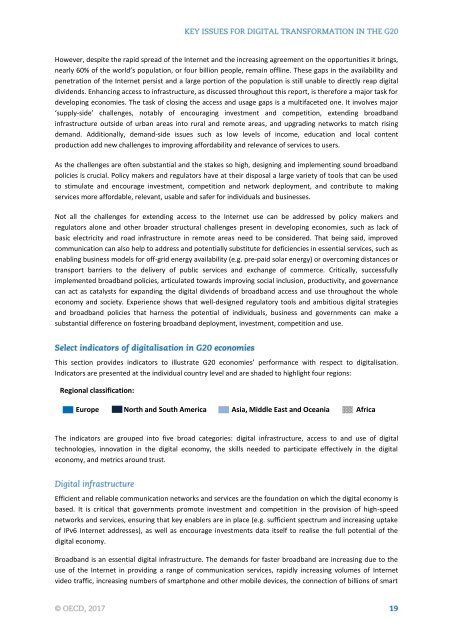KEY ISSUES FOR DIGITAL TRANSFORMATION IN THE G20
2jz0oUm
2jz0oUm
You also want an ePaper? Increase the reach of your titles
YUMPU automatically turns print PDFs into web optimized ePapers that Google loves.
However, despite the rapid spread of the Internet and the increasing agreement on the opportunities it brings,<br />
nearly 60% of the world’s population, or four billion people, remain offline. These gaps in the availability and<br />
penetration of the Internet persist and a large portion of the population is still unable to directly reap digital<br />
dividends. Enhancing access to infrastructure, as discussed throughout this report, is therefore a major task for<br />
developing economies. The task of closing the access and usage gaps is a multifaceted one. It involves major<br />
‘supply-side’ challenges, notably of encouraging investment and competition, extending broadband<br />
infrastructure outside of urban areas into rural and remote areas, and upgrading networks to match rising<br />
demand. Additionally, demand-side issues such as low levels of income, education and local content<br />
production add new challenges to improving affordability and relevance of services to users.<br />
As the challenges are often substantial and the stakes so high, designing and implementing sound broadband<br />
policies is crucial. Policy makers and regulators have at their disposal a large variety of tools that can be used<br />
to stimulate and encourage investment, competition and network deployment, and contribute to making<br />
services more affordable, relevant, usable and safer for individuals and businesses.<br />
Not all the challenges for extending access to the Internet use can be addressed by policy makers and<br />
regulators alone and other broader structural challenges present in developing economies, such as lack of<br />
basic electricity and road infrastructure in remote areas need to be considered. That being said, improved<br />
communication can also help to address and potentially substitute for deficiencies in essential services, such as<br />
enabling business models for off-grid energy availability (e.g. pre-paid solar energy) or overcoming distances or<br />
transport barriers to the delivery of public services and exchange of commerce. Critically, successfully<br />
implemented broadband policies, articulated towards improving social inclusion, productivity, and governance<br />
can act as catalysts for expanding the digital dividends of broadband access and use throughout the whole<br />
economy and society. Experience shows that well-designed regulatory tools and ambitious digital strategies<br />
and broadband policies that harness the potential of individuals, business and governments can make a<br />
substantial difference on fostering broadband deployment, investment, competition and use.<br />
This section provides indicators to illustrate <strong>G20</strong> economies’ performance with respect to digitalisation.<br />
Indicators are presented at the individual country level and are shaded to highlight four regions:<br />
Regional classification:<br />
Europe North and South America Asia, Middle East and Oceania Africa<br />
The indicators are grouped into five broad categories: digital infrastructure, access to and use of digital<br />
technologies, innovation in the digital economy, the skills needed to participate effectively in the digital<br />
economy, and metrics around trust.<br />
Efficient and reliable communication networks and services are the foundation on which the digital economy is<br />
based. It is critical that governments promote investment and competition in the provision of high-speed<br />
networks and services, ensuring that key enablers are in place (e.g. sufficient spectrum and increasing uptake<br />
of IPv6 Internet addresses), as well as encourage investments data itself to realise the full potential of the<br />
digital economy.<br />
Broadband is an essential digital infrastructure. The demands for faster broadband are increasing due to the<br />
use of the Internet in providing a range of communication services, rapidly increasing volumes of Internet<br />
video traffic, increasing numbers of smartphone and other mobile devices, the connection of billions of smart


